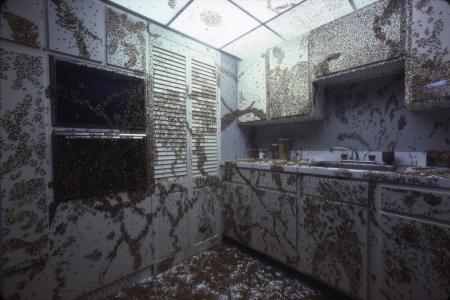Blogs across the Smithsonian will give an inside look at the Institution’s archival collections and practices during a month long blogathon in celebration of October’s American Archives Month. See additional posts from our other participating blogs, as well as related events and resources, on the Smithsonian’s Archives Month website.

Last Halloween, I posted recipes found in our collections for El Hopper Tacos and Infested Fudge (Some Creepy Crawly Recipes in Time for Halloween). Apparently, eating insects doesn't seem creepy to everyone. I thought I'd try again this year with another use for insects.
On May 18, 1979, the Dynamics of Evolution Hall opened at the National Museum of Natural History. It was the first exhibit hall in any American science museum to explain the basic steps of evolution. While the exhibit's status as “the first” or controversies surrounding its subject matter (and lawsuit) may seem like obvious blog post topics, they don't fit with the Halloween theme. Instead, I'm going to focus on the portion of the exhibition that was first brought to my attention – a cockroach-infested kitchen.
Why would an exhibit on evolution contain a kitchen full of cockroaches? The portion of the exhibit was titled "Struggle for Existence: Population Potential." The text explained "Different kinds of organisms produce very different numbers of offspring, but all have the potential to produce populations larger than those that actually occur in nature." An accompanying interactive shows the number of organisms (cardinals, cockroaches, butterfly weeds, oysters, elephants, and humans) in each generation if all offspring survived. The concept was visualized with a model kitchen containing over 130,000 cockroaches – approximately three generations.
Roughly 40,000 freeze-dried cockroaches were prepared by the Insect Zoo (it is unclear from the records where the other 90,000 cockroaches came from, though there is a mention of the donation of an unspecified collection). A document titled "Operation Cockroach" outlined plans for raising the cockroaches over a 10-month period culminating in April 1979.
At this point, there wasn't much time to complete production of the display. In a “Mad Plea for HEPHELPHELP” by Gene Behlen, Chief of Exhibits, recipients (presumably staff and volunteers) were asked to drop by any day the following week to: "Paste roaches all over a kitchen. Paint glue in a small area. Mositen [sic] tip of forcepts in glue. Pick up roach on forcepts and place on the glue." Tips were given to make the process easier and instructions were included for where to place the cockroaches.
Still not creeped out? The final section of Behlen's memorandum was titled "Homework." "Why stare listlessly at the tube this week? If you would 'like' to take work home please do. There are panels in the Rearing Room… You may take them home. Don't forget glue in a small container, a brush, roaches, and forcepts."
Related Resources
- Some Creepy Crawly Recipes in Time for Halloween, The Bigger Picture blog, Smithsonian Institution Archives
Related Collections
- Accession 13-125 - National Museum of Natural History, Office of Education, Exhibition Records, 1978-1979, 1995-1996, 2003, Smithsonian Institution Archives
- Accession 05-084 - National Museum of Natural History, Office of Exhibits, Exhibition Records, 1959-1999, Smithsonian Institution Archives
Produced by the Smithsonian Institution Archives. For copyright questions, please see the Terms of Use.

Leave a Comment